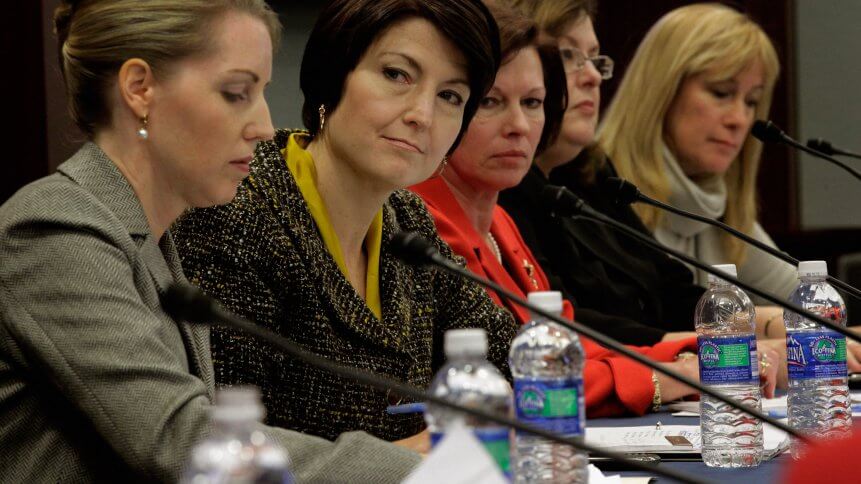What female leaders think about the women in tech glass ceiling

March 8 is International Women’s Day, an annual remembrance and celebration of everything that women have accomplished in the workplace, and beyond. But in the tech industry, women have been woefully underrepresented since the beginning. And despite glimpses of optimism that things are changing, the latest data still shows that there is much to be desired, and much still to be changed before the so-called ‘gender gap’ can be closed between the sexes.
In fact for an industry that prides itself on being at the forefront of innovation and progress, it is most jarring in the tech space when women are still not afforded the same opportunities, have to overcome more hurdles, and indeed, in some instances are still being denied or discouraged from joining technology-affiliated sectors — women are even still being dissuaded from pursuing educational tracks that could result in tech jobs.
Looking at it from certain perspectives, as a matter of fact, the gender discrepancy is wider than ever. According to the World Economic Forum’s Global Gender Gap Report 2021, the time needed to close the global gender gap has increased by the span of an entire generation — from 99.5 years to 135.6 years.
“Gender gaps are more likely in sectors that require disruptive technical skills. For example, in cloud computing, women make up 14% of the workforce; in engineering, 20%; and in data and AI, 32%. While the eight job clusters typically experience a high influx of new talent, at current rates those inflows do not re-balance occupational segregation and transitioning to fields where women are currently underrepresented appears to remain difficult,” noted the 2021 study. “For example, the current share of women in cloud computing is 14.2% and that figure has only improved by 0.2 percentage points, while the share of women in data and AI roles is 32.4% and that figure has seen a mild decline of 0.1 percentage points since February 2018.
And being 2021 data, this report does not even reflect the impact that the pandemic would have had on providing equal opportunity. Various female leaders who have risen to the top of their myriad tech disciplines, share with TechHQ their thoughts and comments on busting through the glass ceiling for women in tech fields.
Megan Barbier, Vice President of People & Culture at identity management platform Jumio
“While International Women’s Day is a day to celebrate women’s accomplishments, we also must stop to remind ourselves of the importance of getting more women recruited into the technology industry by creating an inclusive workplace. All too often, businesses see creating a positive and inclusive workplace environment as an afterthought, and though companies are making great strides in shifting away from this attitude, they can always do more.
“For organizations within the technology sector, improving female representation must become a priority that is actively pursued rather than just a token gesture. The process of shifting the gender balance to include more women can seem overwhelming. Move the needle by weaving diversity into all aspects of the employee experience: talent acquisition, development, and recognition. Providing equitable access to training, projects and other resources, coupled with structured guidance on their professional development, businesses can better support the advancement of women in technical roles.
“Businesses must also reflect on and acknowledge the importance of promoting diversity and inclusion across every aspect of their organization. Diversity and inclusion are key in driving business innovation and creativity. To help women thrive in professional technology environments, leverage the power of both ERGs (employee resource groups) and male colleagues to build a strong community and promote ally-ship. By creating a diverse and inclusive workforce, organizations can tap into a wide range of perspectives and unique ideas, whilst unlocking creativity – all of which add immense value to critical decision making.”
Heidi Pease, Head of Investment Products at fintech Wave Financial
“Cryptocurrency and digital assets in many ways are transforming accessibility to wealth for all people, but unfortunately the tremendous wealth accumulation has almost entirely been with men. As a woman it is painful to witness this disparity, and I call on all women to learn about digital assets to avoid being left behind and, perhaps more importantly, to seize the opportunity to become transformative leaders within this new space.”
YOU MIGHT LIKE

US women are leading the global femtech movement
Anna Stone, Director of CSR at fintech brokerage eToro
“The core challenge is not an industry issue, but rather a cultural issue that women have been raised to not talk about money. It takes bold, confident women to step into a space that has historically been for men, not only in industry but in life as a whole. Representation is key, especially in this space that has been historically a ‘boys club.”
Nicole Sahin, Founder and CEO of global HR platform Globalization Partners
“Companies must live and breathe values that ensure diversity or they risk impacting their ability to recruit top talent. This commitment to diversity has never been more important, as more people than ever have come together to vie for equality and inclusion of all kinds as the workplace of the future resets itself post-pandemic. In my mind, choosing to challenge the status quo reminds us that we each must play a role to help create a more equal world.
“International Women’s Day is a great way to remind ourselves that diversity also plays a major role in how employees feel about their workplace – most notably, in relation to feelings of inclusion, happiness, and trust in leadership. It is my core belief that from recruitment, to development, to establishing female-friendly policies, all businesses must strive to prioritize equality across every aspect of the organization to further accelerate progression. It’s so important to be conscious of what a balanced team looks like, to include people from all walks of life and to be cognizant of what it takes to achieve this.
As a female CEO, I feel incredibly fortunate to be surrounded by an executive team made up of strong female leaders where everyone advocates for equality and inclusion. Together we must champion and celebrate the successes of women around the world who are achieving great things. Though we still have a long way to go in creating a more equal world, together is the only way we will get there.”








